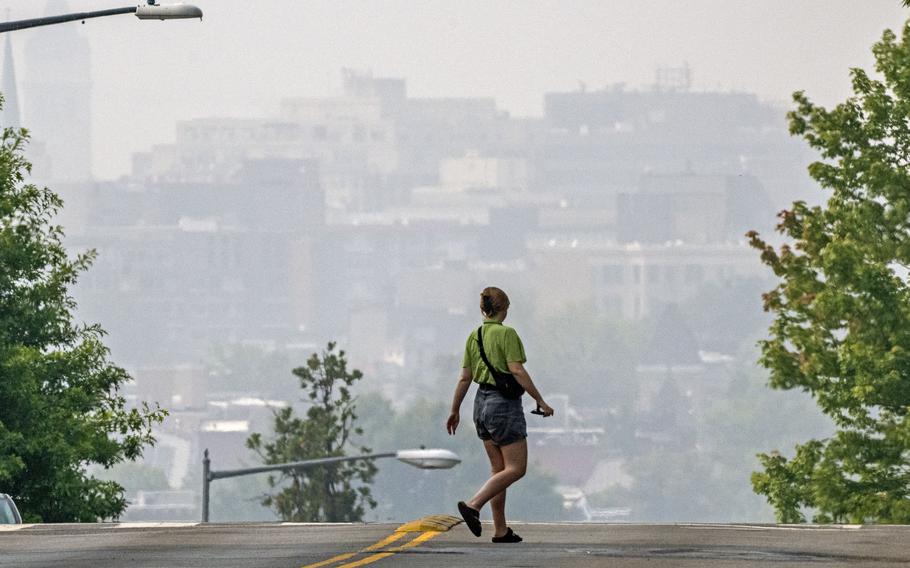U.S.
Millions face a relentless summer of smoke that won’t end anytime soon
The Washington Post June 28, 2023

A woman crosses a street as smoke from the Canadian wildfires renders the cityscape amorphous in Washington, D.C. (Bill O'Leary/The Washington Post)
In Detroit, where air pollution was worse than any other city in the world Thursday, a basement coffee shop became a bunker from the smoke. One Washington summer camp forbade children from an outdoor pool and kept them inside. On a third-straight day of heavy haze in Chicago, an improvement in air quality meant it was merely “unhealthy” to venture outside, rather than “very unhealthy.”
The latest disruptions made it all the more clear: Record-setting, out-of-control Canadian wildfires will not be put out any time soon, meaning more Americans than ever face continuing threats of dangerously poor air quality this summer.
Put differently: The United States could be in for a summer of smoke.
“The number of people that are exposed is unprecedented in the modern era,” said Michael Wara, an energy and climate policy expert at Stanford University.
Air quality alerts covered all or parts of 23 U.S. states Thursday, from Colorado to Vermont, Wisconsin to Georgia. And while residents of Western states have grown accustomed to adjusting their lives to wildfire smoke, Easterners are still adapting to the reality that sooty skies can be a repeated hazard.
As climate change increases the frequency and intensity of wildfires worldwide, unrelenting spring heat and dry weather have fueled Canada’s worst fire season ever observed. That means northerly summer breezes that would normally bring a break from heat waves will carry noxious smoke across the northern U.S. border as long as the fires continue to burn.
“The air quality is worse than Beijing,” said Liz Alford, 36, a federal worker who found refuge in Coffee Down Under, a basement coffee shop in downtown Detroit. “On my way in, I couldn’t even see the cell towers.”
Aboveground, the air was dark and thick, and many older residents wore N95 masks. In Cadillac Square, the giant touch screens that usually help tourists find fun events instead displayed air warnings and notices that outdoor movies, children’s events and yoga classes might be canceled.
Code Red air quality spread across the D.C. area Thursday for the second time this month. Unlike an intrusion of wildfire smoke that hit in early June, which occurred toward the end of the school year, the latest episode coincides with summer camps now underway.
“It’s such a challenge because so much of camp is about the outdoors and getting kids outside,” said Drew Mackay, director of the summer program at Beauvoir, an elementary school at Washington National Cathedral. Mackay said that on Code Red days, campers are limited to no more than 10 minutes outside at a time and outdoor swimming is canceled.
“This seems new and I’m afraid it might become the new normal,” Mackay said.
Washington’s air quality was among the worst for major cities around the world Thursday, along with Detroit, Chicago, Minneapolis and New York. The air was worse in Detroit and Washington than in Lahore, Pakistan; Dubai; and Shenyang, China, according to IQAir.
Air quality reached Code Purple, considered “very unhealthy” for the general public, in places such as Canton, Ohio; Pittsburgh; and Madison, Wis.
The smoke was so far-reaching and concentrated simply because of the volume emanating from Canada — and because summer weather patterns prevent it from dissipating quickly.
Hundreds of large fires are burning, half of which the Canadian Interagency Forest Fire Centre lists as “out of control,” with 31,000 square miles already torched this year, an area larger than South Carolina.
Together, a high pressure system swirling clockwise over the Tennessee Valley and remnants of an area of low pressure circulating counterclockwise over the Great Lakes were acting like a conveyor belt, pumping from Canada into the Great Lakes, Ohio Valley and Mid-Atlantic. Such weather patterns can act “just like a funnel” for smoke, said Christine Wiedinmyer, an atmospheric chemist at the Cooperative Institute for Research in Environmental Sciences at the University of Colorado at Boulder.
And with so much smoke, it can be slow to clear up quickly, Wiedinmyer said. Major differences in temperature and pressure are needed to fuel strong winds, but at this time of year, with summer in full swing in the Northern Hemisphere, that sort of rapid flow is missing,
“You need a lot of mixing and time for the plumes to spread out and to diffuse,” she said.
Greg Carbin, chief of forecast operations for the National Weather Service’s Weather Prediction Center, said that while air quality conditions are forecast to improve by the weekend in the eastern part of the country, more smoke incursions will be ahead. The next one could target New England after the Fourth of July, he said.
“Smoke is going to continue to be around in the atmosphere,” Carbin said. “The Northern states are far more likely to be influenced by occasional bouts of poor air quality.”
Air quality is forecast to begin to improve for most of the country Friday and into the weekend, as the flow of smoky air into the eastern U.S. from the north and northwest is replaced by cleaner air coming from the south and southwest. With that will also come increased humidity and daily thunderstorm chances.
Heavy rainfall can help “mop up” smoke from the air, dramatically improving air quality by removing particles that stick to water droplets as they condense, Wara said.
But more smoke could blow in before long, and there is no sign that Canadian wildfires will let up before snow arrives, he said.
“There could be some very smoky days ahead,” he said. “This is the future, unfortunately.”
The Washington Post’s Emily Wax-Thibodeaux, Kim Bellware, Justine McDaniel and Dan Stillman contributed to this report.